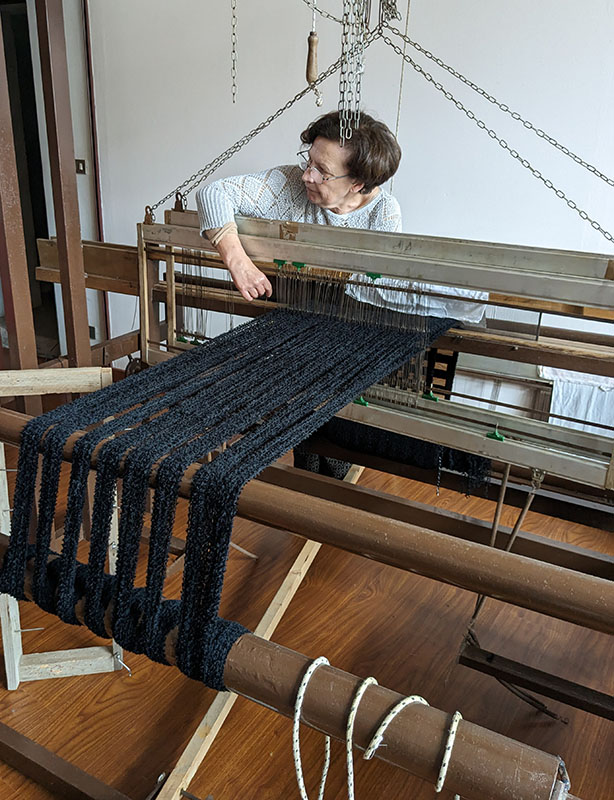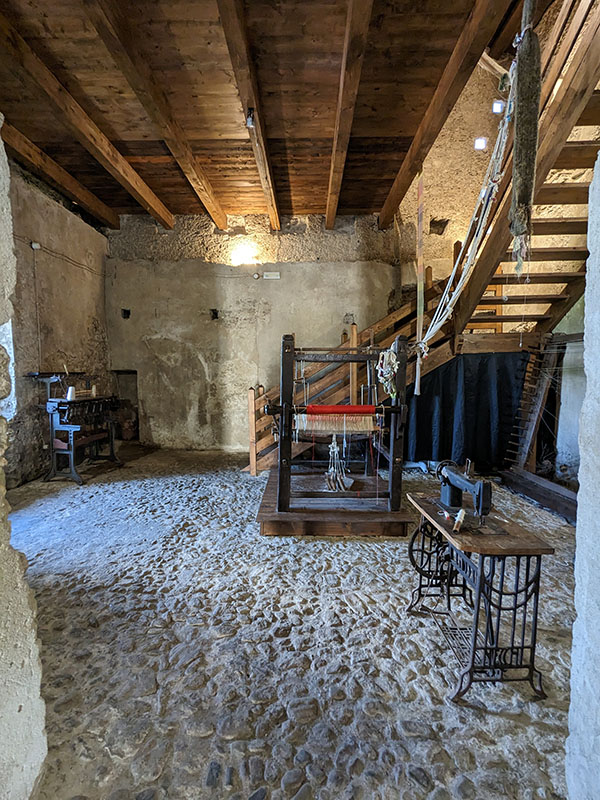Calabrian Silk: Tradition and Tenacity
by Tracy Meserve
A Decorative Arts Trust Research Grant supported my travels from Palermo, Sicily, to the Cantanzaro region of Calabria in order to research the history of silk in the region. Calabria’s role in the history of silk in Italy has been underrepresented in academic literature despite a history dating back to the Byzantine Empire. Silk-making continues in the region, and the goal of my trip was to meet with two organizations that are continuing the craft today: Dal Baco alla Seta (From Worm to Silk) and Nido di Seta (Silk Nest).
My first stop was to the town of Cortale to visit Marianna Bertuca of Dal Baco alla Seta (figure 1). With the help of an interpreter, Cristina Orso Manzonetta, Marianna gave me over an hour of her time and thoroughly answered all of my questions about her role in preserving the weaver’s craft.
Marianna started her business in the 1980s, with her husband and mother-in-law. In her workshop, she owned a 16th-century loom as well as a jacquard loom that was made for her in Florence. Marianna was familiar with multiple techniques of making silk, from the ancient methods to the more modern. Marianna relayed the success of her business in the 1990s, when the media took an active interest in her work. Interest waned, however, and she adapted her practice over the years. She initially sold silk bed covers before transitioning to jewelry and smaller textiles when tastes changed. At one point, Marianna was raising 20,000 silkworms a year, but now only raises 1,000. She mentioned that the large amount of rain in Italy this year affected her worms, as silkworms cannot digest water, which raised an interesting discussion on how climate change will affect silk-making in the future. I departed Dal Baco alla Seta amazed by Marianna’s craftsmanship but also thinking that her work has never been fully appreciated.
The next morning, Cristina gave me a tour of the silk museum in the town of San Floro (figure 2). The museum had examples of silk made in Calabria from the 18th to 20th centuries. Cristina said that “there was a loom in every house in Calabria until my grandmother’s time,” but the communal memory of the weaver’s art was gradually forgotten. When Miriam, Giovanna, and Domenico, the founders of Nido di Seta, started their business, they learned from an 89-year-old woman named Angeluzza, who used a lullaby that was taught to her at a young age to remember how to weave on the loom.
After a tour of the museum, Florino Vivino, the former mayor of San Floro, drove me to see some of the longstanding mulberry trees that still exist in the area. He explained that the entire region was covered with these trees until they were knocked down in the 1800s to make room for olive trees. Some of the trees he showed me were between 150 and 200 years old. From there, we drove to see Nido di Seta’s mulberry grove and cooperative. I saw 25,000 worms in their 5th stage of development (figure 4), and I could hear the worms munching on the mulberry leaves! In addition, 30,000 silkworms had been born that very morning. The cooperative had to drastically scale up their production after Gucci invested in the company to produce a line of naturally dyed Calabrian silk scarves that will be sold at a future date.
The contrast between Nido di Seta, in some ways the next generation of silk-makers in Calabria, and Dal Baco alla Seta made for a rewarding research trip that provided invaluable primary source material for my thesis.
Tracy Meserve is a Masters student in Decorative Arts and Design History at George Washington University. She currently serves as the librarian at the George Washington University Museum and The Textile Museum.
About The Decorative Arts Trust Bulletin
Formerly known as the "blog,” the Bulletin features new research and scholarship, travelogues, book reviews, and museum and gallery exhibitions. The Bulletin complements The Magazine of the Decorative Arts Trust, our biannual members publication.
Click Images to Enlarge
Did you know that clicking on the images in Bulletin posts will allow you to get a closer look? Simply click on an image, and a larger version will open in a pop-up window.










